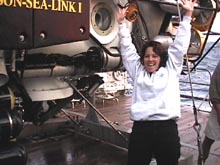Crew members track the submersible on the bridge. Click image for larger view.
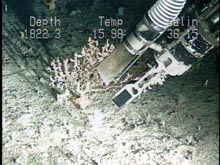
The submersible has a mechanical arm for collecting samples. Click image for larger view.
Science is Everywhere!
September 29, 2001
Carmelina Livingston
Educator At Sea
South Carolina Aquarium
Charleston, SC
![]() View a video of Carmelina's exuberant return from a sub dive. (3.8 MB, QuickTime
View a video of Carmelina's exuberant return from a sub dive. (3.8 MB, QuickTime ![]() required).
required).
Teachers often search for the best teaching practices to stimulate, engage and instruct students. The search to find activities, lessons, materials and resources are constant daily routines for teachers. How can teachers make learning innovating, thought provoking and at the same time, keep instruction aligned with the curriculum standards? One of US National Education Goals mentions "our country will be first in the world in mathematics, science and technology". This goal is a challenge to many science educators, but the challenge can be achieved. Many people do not realize that science is everywhere and science instruction can be taught through real-world experiences everyday! I had the privilege to experience real-world science on the Seward Johnson II research vessel and on the Johnson Sea-Link submersible dive on the Charleston Bump leg.
On the afternoon of September 28, I was able to dive to more than 1800 feet aboard the submersible Johnson Sea-Link. As the submersible launched off the ship's deck, I realized that the total experience reinforced many life, earth and physical science concepts. The use of technology was an integral part of the dive. Various technological instruments were used simultaneously to gather oceanographic, atmospheric, navigational and fisheries data. The communicative data augmented my learning experience. In the submersible I had a monitor in front of me to see the present depth, temperature and salinity of the water. The sensors outside the submersible provided this information. Video and still cameras recorded images of fish, crabs, urchins, sea stars, corals and the ocean floor habitats. The submersible's pilot was in constant communication with the research vessel by using the underwater telephone and the tracking system device that are both vital sources of real-time data. The use of global positioning system (GPS) on the ship and an Integrated Mission Profiler (IMP) on the submersible assisted in communicating information. These instruments indicate the sub's position relative to the ship's position in space. The submersible's robotic arm and vacuum tube were used to gather specimens of animals and sediments.

Each color has a different wavelength. Violet has the least amount of energy and has the shortest wavelength while red has the most amount of energy and has the longest wavelength.
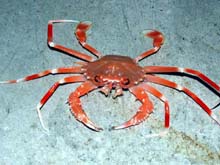
This crab was collected from deep in the ocean. The red color helps protect it from predators. click image for larger view.
As I looked out of the two portholes in the stern of the submersible, I could see how the biological and geological factors worked hand in hand. The current of the Gulf Stream was flowing at a steady pace picking up loose sediments along the rocky-bottom seafloor. In some places very little life was visible, with only a few scattered corals around pieces of rocks sticking up from the floor. Besides the sparse corals and rocks, I could see fish, sea urchins, sea stars and crabs dodging the current. The submersible came across some small ledges (about 1-2 feet high). Animals were hiding under the ledges and in the crevices of the rocks. The submersible then came to a depression in the ocean floor at a depth of 1850 feet. The seafloor seemed to be made of course sediments with no visible life. I started to really look at the floor and, to my surprise, I began to see life camouflaged within the sediments.
Physical science was all around me during the dive. The current was strong at about 1-2 knots. It was easier for the sub to flow with the current than against the current. I would occasionally see sediments or pieces of coral moving by the porthole windows, which indicated the submersible was "going with the flow". I could also tell when the current was not so strong because I would notice small one inch red shrimp swimming around the sub's light just outside my window like moths swarming around a porch light. I was amazed to see how life can exist so deep in the ocean without any light. Many of the deep-water animals I saw were the color of red or dark orange. Why? White light contains the entire spectrum of colors seen in a rainbow. All colors in white light travel at the same speed, but have different amounts of energy. Each color has a different wavelength. Violet has the least amount of energy and has the shortest wavelength while red has the most amount of energy and has the longest wavelength. The color of the ocean water reflects blue light at great depths whereas red light is absorbed and converted to heat. Red objects beneath the surface look gray. Many deep-water animals are red or dark orange because red light does not penetrate deep in the ocean. This adaptation of color helps animals protect themselves against predators. On my dive, I saw red sea stars, red crabs, red-orange polyps on coral and red-orange fish such as the pink frogmouth and the blackbelly rosefish fish. Even the sea urchins had a red-orange hue to their test.
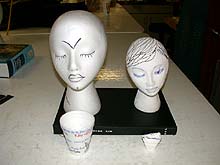
The objects on the right have been compressed due to the pressure of ocean water. Click image for larger view.
![]() The excitement to discover and learn something new is a powerful tool to increase knowledge. Click image for video of Carmelina Livingston's excitement upon returning from the depths.
The excitement to discover and learn something new is a powerful tool to increase knowledge. Click image for video of Carmelina Livingston's excitement upon returning from the depths.
Prior to the Charleston Bump leg, I had decided to conduct a simple experiment while on the ship. I wanted to find out the strength of pressure at the deepest depths of three different submersible dives. Pressure is caused by the weight of the water overhead. Knowing that the pressure is greater as the depth increases, I wanted to test my hypotheses. Hypothesis 1: If the depth of the submersible's dive increases, then pressure is greater. Hypothesis 2: If the pressure is greater, then pressure can shrink the size of the wighead and cup. I brought three styrofoam wigheads (adult size) and cups on board. On three different dives at various depths from 1600 ft to almost 1900 ft, a wighead and a styrofoam cup were placed in a mesh bag and placed in a compartment outside the submersible. After each dive, the wigheads had shrunken down to a newborn size of a baby’s head and the cups had shrunken down to a third of its original size. The wigheads weighed about 100 grams each prior to the dive and weighed an average of 145 grams after the dive. Why did the wigheads weigh more? One speculation is that as the wigheads shrunk in size because of the pressure, water was trapped in the airspaces.
I have only hit the tip of the iceberg by recognizing that science was everywhere in the dive experience. If we as scientists and educators can continue to work collaboratively in sharing our passions for the love of science and bringing real-world opportunities for students, learning can be achieved at the highest level. The excitement to discover and learn something new is a powerful tool to increase knowledge. Thank you for an experience of a lifetime!
The Seward Johnson II – A Student’s Perspective
September 29, 2001
Katie Jocelyn Ramsey
University of Charleston
Sorting plankton – the act of separating fish larvae, invertebrates, and plant life – has been my life for the past several months. As a graduate student, I realize this tedious task is part of learning about today’s fish populations, but I wish I could have helped collect these samples that stare me in the face, day in and day out. Well, my time has finally come. I was given the opportunity to participate on a research vessel involving several different goals including the collection of plankton samples, and the collection of bottom sediments, corals, and sponges.
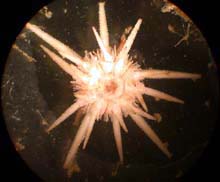
A microscopic photograph of a sea urchin from the plankton collection on the Seward Johnson II. Click image for larger view.

A magnified photo of a myctophid larvae. Click image for larger view.
Participating in the fieldwork has been a new and exciting experience. During the day, the submersible on the ship brought in samples from the ocean floor from depths of up to 1800 feet. We have seen a variety of coral, fish, sponges, and several other examples of marine life.
At night, I helped collect plankton samples from different locations in the vicinity of the Charleston Bump. Observing the plankton samples immediately after being collected in the nets was a wonderful experience. The characteristics of the species collected seem more impressive than seeing them each day in the lab. One of the most noticeable differences is the variety of colors seen in the samples collected on board. The first night larvae of the midwater lanternfish that possess light organs, the ribbon-like leptocephala larva of eels, flatfish, and many other fish larvae were seen with the naked eye. After viewing a few of the larvae under the microscope, we identified a few jacks, filefish, and a billfish. Perhaps the most intriguing identification was the scorpaenid larva we discovered because the following day, the submersible brought up a blackbelly rosefish. Comparing and contrasting the larval and the adult stages of this fish was quite interesting!Being able to participate in the collection of the samples that will be used for my master’s thesis has been extremely valuable. On this trip I have been able to experience firsthand the importance of fieldwork in protecting our natural resources and their habitats. The diversity of the millions of species that inhabit our oceans has always been impressive to me, but after being allowed this experience, I now know that being able to observe that diversity is truly priceless.
Sign up for the Ocean Explorer E-mail Update List.












































